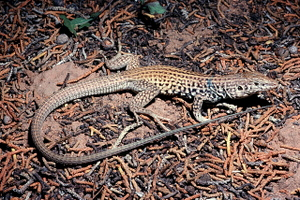These whiptails forage widely and intensively, probing into leaf litter, digging out buried prey, and sometimes climbing into plants to obtain prey (primarily arthropods). Much flicking of the tongue suggests that odors help reveal potential prey.
Photo Credit: Geoffrey A. Hammerson
Aspidoscelis tigris
Common Name: western whiptail
Other Common Names: huico tigre, tiger whiptail
Other Scientific Names: Cnemidophorus tigris
Animal Guild: Reptile
Class > Order > Family: Reptilia > Squamata > Teiidae
What does the species look like?
These lizards have a long and slender body, small granular scales on the back, and larger rectangular scales on the belly. Belly scales are unmarked or have black marks on the front edge of some scales. The upper side often has light stripes; the dark fields between the light stripes are interrupted by light areas, or the dark fields are broken into separate bars or spots, or the pattern may be more or less marbled. The scales along the front edge of the fold of skin across the throat are not conspicuously enlarged. The throat may be pinkish or orangish in adults. Maximum size is about 5 inches (12.7 cm) snout-vent length. Hatchlings are orange-yellow with dark brown-black spots, stripes, or marbling; the tail is bright blue.
Where is the species found?
States & Provinces
AZ, CA, CO, ID, NM, NV, OR, TX, UT
Distribution
The range extends from Oregon and Idaho to southern Baja California, Sinaloa, and southern Coahuila; west to California, east to Colorado and Texas. This includes the range of the marbled whiptail (Aspidoscelis tigris marmorata), which some list as a distinct (but "incompletely separated") species.
Habitat includes deserts and semiarid shrublands, usually in areas with sparse vegetation; also woodland, open dry forest, and riparian growth. Soil may be firm, sandy, or rocky. Lizards seek shelter in underground burrows (dug by rodent or lizard) or under surface objects.
General Phenology and Life History
Activity occurs in warm daylight hours. Adults are active mainly April-September in the north. Juveniles have a longer activity season and may be active earlier in spring and later in summer and (in the southern part of the range) on warm days in winter. At the northern end of the range, mating occurs in the first half of June, egg laying occurs in late June and July, individual females produce one clutch per year, and hatchlings appear by mid-August. In Colorado, courtship and mating occur from late May to mid-June, eggs are laid in mid- to late June, and eggs hatch in early August. At the southern end of the range in Mexico, egg laying occurs as early as early May, hatchlings first appear as early as mid-June, and individual females may produce two clutches each year. Clutch size averages between 2 and 4. Eggs are laid in soil/underground.
Which phenophases should I observe?
Do you see/hear...?
Activity
Individuals on land More...
For abundance, enter the number of individual animals observed in this phenophase.
Feeding For abundance, enter the number of individual animals observed in this phenophase.
Development
Young individuals For abundance, enter the number of individual animals observed in this phenophase.
Dead individuals For abundance, enter the number of individual animals observed in this phenophase.
What do these phenophases look like?
There is currently no photoguide available for this species. If you'd like help us create one, use the guidance document and species template provided here . Then send it via email to education@usanpn.org when it is complete.
